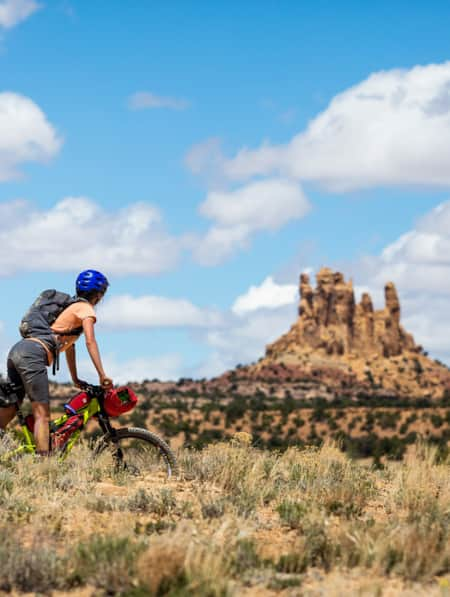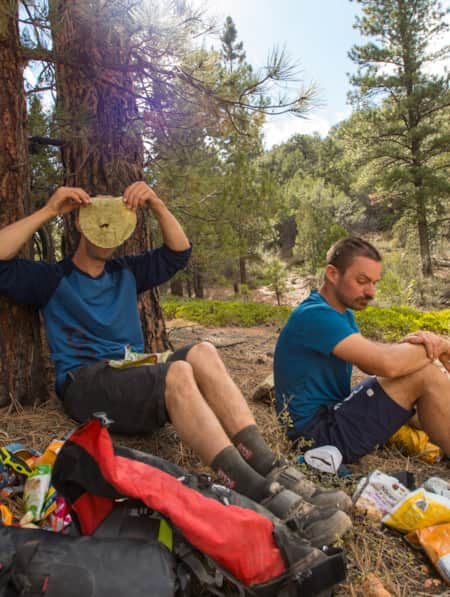Trail Overview
Trail Length: 12.7 miles total, including the 3-mile Practice Loop
Riding Time: 1-2.5 hours
Difficulty: Difficult; the challenge comes from steep, sustained climbs matched by steep descents along with sandpits
Elevation Gain: 760 feet
Pets: Dogs are allowed on leash, but not recommended. Slickrock can be harsh on a dog's feet.
Permitted Traffic: Mountain bikes, hikers, motorcycles
GPS Coordinates: 38.5814, -109.519395
To get to the Sand Flats Recreation Area from the north and Interstate 70, take Exit 182 toward Moab. Merge onto US-191 and go south 31 miles to the third traffic light. At this light turn left onto 100 North. Proceed one mile and turn right onto 400 East. Go 1.5 miles and turn left at Dave’s Corner Market onto Millcreek Drive. Proceed for one mile to the stop sign. Go straight at the stop sign onto the Sand Flats Road that continues up a hill for approximately one mile to the entrance booth.
To get to the Sand Flats Recreation Area from south of Moab on U.S. 191, turn right at the first traffic light onto 400 East. Proceed for one mile to Dave’s Corner Market and Millcreek Drive. Make a right onto Millcreek Drive and proceed for one mile to the stop sign. Go straight at the stop sign onto the Sand Flats Road that continues up a hill for approximately one mile to the entrance booth. The Slickrock National Recreation Trail parking lot is just beyond the entrance station on the left. You can't miss it.

The challenge of the Slickrock Trail comes from steep, sustained climbs matched by steep descents along with sandpits.
The start of the trail is very well marked. There’s a large parking area along with some bathrooms. As you cross the raised metal grate you begin the Slickrock experience — on busier days you’ll find hikers and mountain bikers all jostling for position on what can be a rather busy trail. (Yep, the secret’s out on this one.)
True beginners will find themselves out of their element here, but if you want to assess if you’ve got what it takes, then it helps to check out the much-shorter Practice Loop. It’s every bit as difficult as the full loop, and you’ll still pass some amazing scenery, but it’s only two miles. If you find yourself out of your comfort zone, it’s not a terribly long walk back to the start. You can also use the Practice Loop as a big playground to get the sense of what the riding is like at Slickrock. Once you get in a groove, find your balance and feel nice and fired up, then proceed onward for the full loop.
Formed from a mixture of petrified sand dunes and the seabed of an ancient ocean, the Slickrock Trail winds around the edges, tops and bases of humongous mounds of rock. The slickrock surface will change your understanding of what’s rideable. The relationship between the rubber on your tire and sandstone is something special. You’ll be surprised how well your tires grip to the rock surface even when you don’t expect them to.
A typical problem: Many more people get scraped up hopping off the bike and falling on an elbow than they do if they stay on and persevere through a steep spot. The surface acts as a bit of a cheese-grater on exposed skin, so it usually pays off to buckle down and pedal through rather than give up. (The cacti dotting the landscape are also regrettable landing-zones if you fall, so just focus on staying in the saddle.)
Anticipate the ride taking about 2 1/2 hours (or just more than 3 hours if riding from Moab). Especially if you’re new to desert riding, bring more water and snacks than you think you’ll need. Budget plenty of time to really drink in the sweeping vistas at Utah's scenic overlooks.
Keep in mind that this trail out of Moab isn't exactly a secret and sees a lot of traffic. It’s also not a ride for a beginner mountain biker. You need good fitness and very solid bike handling skills. If you time it right, and you have the technical chops to complete the trail, you’ll surely be glad you checked it off your list.
Best Time to Ride the Slickrock Trail
Moab's prime season is from March through May, then September through November. Summer sun can be punishingly hot and you'll already be working your lungs off fighting up the climbs on Slickrock, so unless you're a glutton for overbearing heat, avoid the peak summer months. Winter in Moab can actually be quite pleasant for riding the Slickrock Trail, especially if you get a day in the mid-50s to help cool your engine, so to speak, from the sustained climbing efforts. You'll also see fewer riders in the off-season.
During the prime months, an early start is advised for cooler temps and less traffic. A twilight ride can be fun, too but the Slickrock Trail is not a place you want to be at night if you don't have a good lighting system on your bike.
Things to Know
- Want to master the climbs? Trust your tires to stick to the rock, keep your weight close to your back tire, and resist the urge to bail when it feels like your tires are going to slip out from under you.
- Outside of the steep climbs and descents, the trail itself isn't all that technical in the traditional sense of the term — there are no huge drops, rock gardens or gnarly roots to contend with. The sandpits can be annoying, especially if you try the old "crazy legs" strategy to get through them. Keep your legs moving, stay loose, and don't oversteer in the sand.
- The Practice Loop is a great (and aptly named) intro to the Slickrock Trail. Hone your skills there, then go for it on the primary loop.

The Slickrock Trail is one of the more famous trails in Moab.

You'll see less traffic along the Slickrock Trail in the winter months.

The Slickrock Trail landscape is made up of petrified sand dunes and the remains of an ancient seabed.















